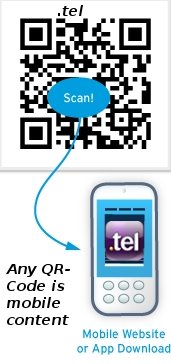Telnic's endeavours within the directory industry
First of all:
The Dot Tel domain was not really made for directories in the first place, respectively, for .Tel to be mainly a directory, as its main purpose.
However, the biggest fans of .Tel, and the most active .Tel community members, all had created one ore more directories, and which some of them, are quite impressing.
So, the .Tel directory got more popularity amongst the fans of .Tel, than the .Tel registry (Telnic) had ever dreamt of.
Soon after the first .Tel directoies had been created, a few of them allready reached the limit of 1000 subfolders, so that the limitation was expanded to 3000 subfolders.
But they sufferd due to poor looks and design, at first, but which had been improoven in the meantime. Probably still lacking some more design features, but then again, these had been already announced in the .tel Roadmap. This sounds promissing, and so, as long as there are constant improvements going on, the .tel directories will get more and more interesting, and better to navigate.
Another very important thing, from which the .tel directories will surely benefit from, is the fact, that the new markting director previously worked for „yell.com“, and brings quasi the best experience and knowledge about online directories.
So, what we see here, is very strong support for the development of Dot Tel directories, strenghtening and supporting it, for the long term future.
Not only is the new marketing director present, but he is also very active, attending all sorts of congresses and events around the directory publishing business, to make .Tel directories to become better directories.
The focus here, is is clearly, on designing and managing online (mobile phone) directories, and where advertising plays a very important role.
In this respect, the .Tel holder/owner, is also a advertiser, respectively, a online advertiser, generating more business, through advertising.
It is clear, that this advertiser needs all sorts of help from the .Tel registry, as well as tools that help online advertising.
An interesting question is:
What can you learn from attending an EADP Congress (European Association of Directory Publishers)?:
Lets take a closer look:
Firstly, mind you: All these talks around directories, are strongly focused on the „yellow pages system“, which in contrast to .Tel, bring earnings to the provider of the yellow pages directory.
With .Tel, it is a whole different story, as there is not just one owner or provider, but thousands of individual directory owners, hoping to get some tidy revenue, sooner or later...
Call it: Digital revenues for .Tel holders.
Be aware, that you, as a .tel directory developer/creator and owner/holder, is working within newer categories, such as reputation management, SEO, social and mobile.
Nota Bene:
Digital trends highlighted in the forecast include:
· U.S. – Digital revenues in the United States will grow at a 17.2 percent compound annual growth rate (CAGR) as the result of publishers selling a wider array of digital products. BIA/Kelsey expects strong growth from some of the more established digital offerings, including Web sites, SEM and video. Growth will be even more robust in newer categories such as reputation management, SEO, social and mobile.
· Europe – Digital revenues will surpass print revenues across Europe by 2014, and even sooner in several markets, including Norway, Sweden, Finland, Denmark, Belgium and France.
Ok: So you do understand, that with the field of online directories and digital revenus, there will be a lot happening, between now (2011) and 2014, which is about a three year time frame.
Now, if Digital revenues will even surpass print revenues, than I must not explain, that there is a lot of earning potential in any sort of online directory, including the Dot Tel domain (directory).
You probably can mostly learn, from what is going on, about online yellow pages, and go from there, making your .Tel directory look good and to be profitable.
Looking at all this future potential, it seems to be very clear, that the Dot Tel directory was completly underestimated, up and till now, by anyone, who either just heard about it, or who had also been creating such directories. I believe, it is somewhat hard, to invest time and passion in creating a directory, having no big clue, where those endeavours will eventually lead to.
It was quasi only the believe in .tel directories, to become some day, something bigger and more important, and more used by the masses.
Following all the talk about yellow pages, gives you the impression that it is a science, for its own.
Again: We are talking about the global development of the directories market, and especially about Dot Tel directories within this market. And furthermore, it is about publishers and suppliers of products and services for the publishing industry, that is going more and more online.
The word "directory" no longer covers the broad and complex range of services (including printed and vocal resources, web agency and mobile services) that companies are now offering.
If you are serious and ambitious about promoting .Tel directoies, than they will clearly become highly competitive against directoies, such as „yellow and white pages“.
The Yellow and White pages are established directories backed up by a lot of know how, experience, and last but not least, a big community of financially strong businesses, working with these directories, making their profits, and constantly educating themselfs about futur trends and the best strategies to proceed, to becoming more successful, or to outperform competitors.
You must also know, that other people within the directory business, are working day and night, because the directory business is a 200% job, if not more. At least this is my impression.
That is why Telnic and all .Tel directory owners, need to catch up and update themselfs about the present situation within the directory publishing business. And also, if Telnic wants to become a principal player withing the directory publishing business.
A Dot Tel directory gives you the opportunity to search for suppliers of goods and services, and it allows businesses, worldwide, to promote themselves to potential customers in other countries cheaply and easily. But this also applies to local online directories.
About the use of scannable barcodes in advertising (within directories):
Online Media Daily writes about the use of scannable barcodes in advertising, which when scanned by a camera phone can provide extra information on products or companies. Barcode technology provider ScanBuy claims that there were more barcode scans performed in a single month starting in July than in all of 2009. Scanning via the company's barcode system has increased 700% from the start of 2010. ScanBuy found both 1D and 2D codes are being scanned about equally, "showing people are less concerned with code format, and more interested in getting information quickly," according to the company. Linking to a Web site was by far the most common type of action encouraged by a 2D code, with 85% driving traffic to a URL. Among traditional 1D, or UPC, codes, health and beauty products were the most popular category, making up 21% of scans, followed by groceries (14.4%), books (12.6%), and kitchen items (9.2%). ScanBuy said people are also actually making purchases through mobile devices, with books and electronics showing among the highest conversion rates. (Source: Online Media Daily)
About social media on mobile phones:
Dot Tel domains enable easier access to Facebook on mobile phones: This is exactly, what Facebook wants to happen on mobile phones, so that it can keep up its dizzying growth.
By adding a Facebook link to your online contact info- or business card, you can be sure, that users will be also looking up Dot Tel domains, to find Facebook pages. The Facebook link on a .Tel, is probable one of the easiest ways to find a Facebook page. Soon .Tel and Facebook, and vis versa, will be assosiated together, and not only Google with Facebook.
About Google and advertising:
For all of Google’s success, its business has been built on search ads, with display ads which include images, video and audio getting far less attention, even though those ads appear on You Tube and the million Web sites using Google’s display ad network.
Just another thing:
The Dot Tel domain makes it so much easier to contact local merchants directly from a mobile website, because the Dot Tel contact information is right at the palm of your hand, and you do not have to search for it, within a cluttered up heavy website.
Taking this in account, advertising on .Tel's become more attractive, than advetising on big websites (from which most of them are not mobile websites).
And:
Location based Web services are no longer a hard sell, because you can offer them via a Dot Tel domain, where they can be viewed on the go. That means, that if you are somewhere with your smart phone, you can figure out, where to find the local services and products. No need to go to the next internet cafe...
Dot Tel directories, will get interesting for advertisers, including categories covering popular businesses and services such as beauty salons, driving schools, florists, hairdressers, pubs, restaurants and takeaways.
Advertising across the Facebook platform, as well, and linking Facebook to your .Tel, which has adverts, too, will sure make you be found, as a small local business.
Data on mobile phones, will be more important than voice, which is another reason, why the Dot Tel domain should not be abandoned, but payed a lot of attention and care to.
Neither are you a heavy users of mobile data, if you often use .Tel, because .Tel is light weight data on mobile pages. Often using .Tel, is economic and cost efficient.
After all, I have talked about, here, it seems to me, that online directories, is a lot about advertising, as well. Which means, that online directory owner, will be the ones, making most digital revenues on mobile phones, such as iPhones, or on other mobile devices, such as iPads.
The Dot Tel domain, is one of the latest innovations for the directory and database industry.








































































